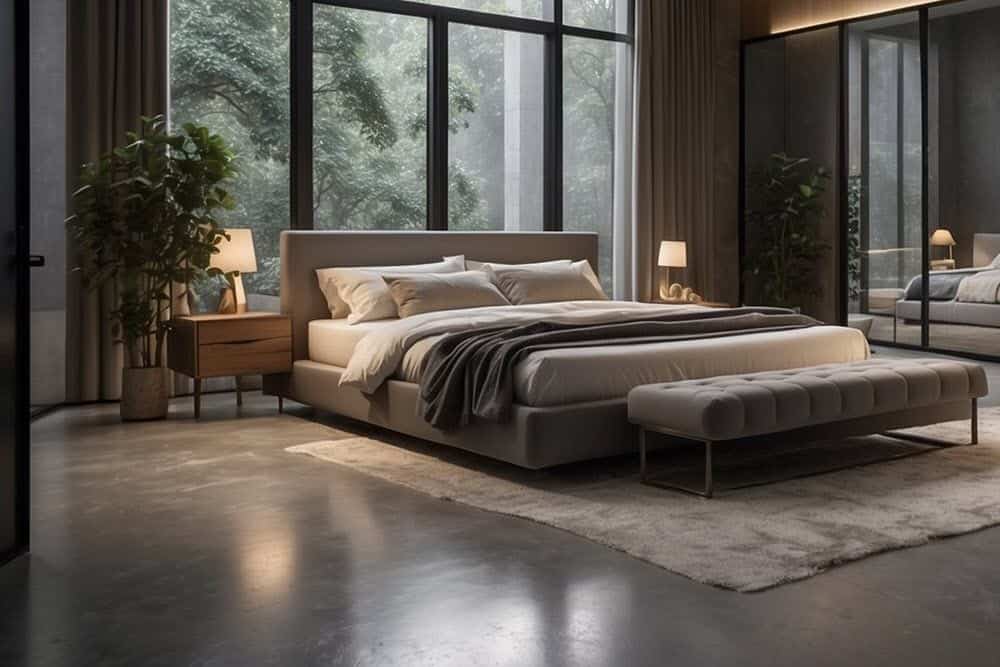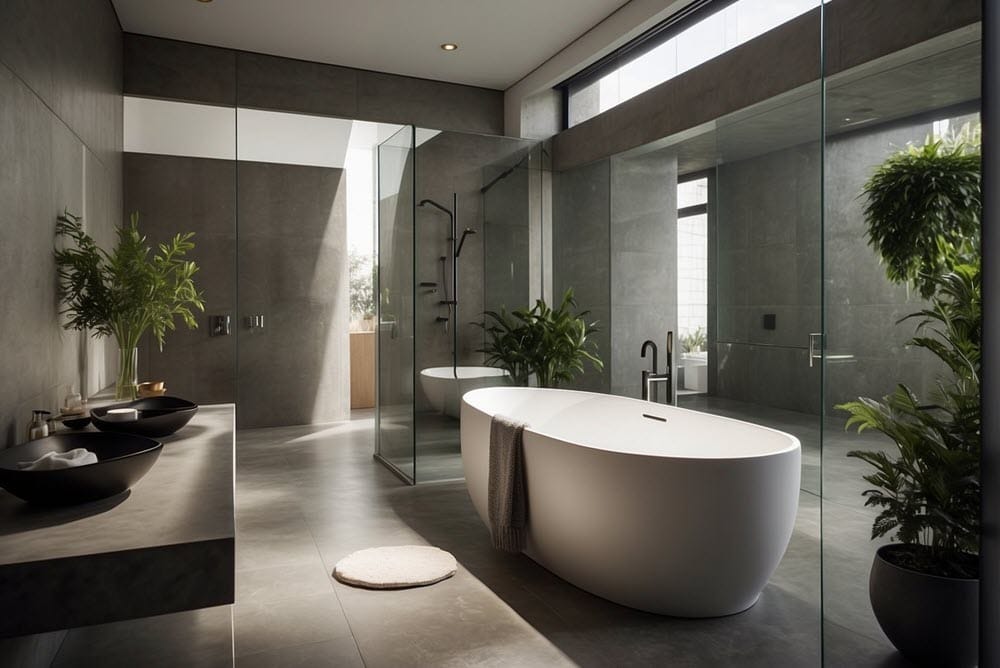Residential Polished Concrete Overview
This post was inspired by an article posted on Dwell.com and features two “cabins” in the Hamptons on Long Island – one of which makes extensive use of concrete throughout the entire interior. The cabins are currently on the market – and one of the cabins offers a huge advantage: polished concrete – that most homes don’t have.
Residential polished concrete offers an innovative flooring option that combines durability and design flexibility. This modern flooring choice comes with a smooth, high-luster finish that can elevate the aesthetic of any home. Builders and designers turn to polished concrete floors for their low maintenance needs and the long-term value they provide.
Key Features & Benefits:
- Durability: Concrete floors stand up well to heavy foot traffic and resist wear over time.
- Affordable: Polished concrete is often more budget-friendly than other flooring materials.
- Design Options: Homeowners can choose from a variety of colors, textures, and patterns.
- Long-Term Durability: With proper care, these floors last for years without the need for replacement.
- Low Maintenance: Simple cleaning routines suffice, keeping upkeep costs down.
- Versatile: Fits various design themes, from industrial to modern.
- Reflectivity: This feature enhances the natural light within a home, reducing the need for artificial lighting.
During the polishing process, technicians may add colors, dyes, or stains to the concrete to create unique, personalized looks. They use concrete stains to achieve rich tones, while dyes offer vibrant shades. Contractors also apply a densifier to the concrete; it fills the pores, increasing strength and preventing dusting. A protective seal often follows, shielding the surface from stains and enhancing sheen.
Architects appreciate polished concrete for its ability to integrate with other natural materials in a home, such as wood or stone. Whether in a new build or updating an existing concrete floor, the seamless integration of polished concrete with elements like open trusses and ambient heat systems results in a cohesive architectural design.
Builders emphasize that polished concrete floors align with the increasing demand for sustainable and eco-friendly homes. The material’s ability to store and radiate heat contributes to energy efficiency. Additionally, the reflective surface can improve light distribution, further cutting down on energy use.
Polished Concrete Floors For Kitchens Overview
Polished concrete floors offer a sleek and modern look in kitchens while providing functional benefits. These surfaces attract architects and designers for their versatility and design options.
Pros Of Polished Concrete In Kitchens
Durability and Maintenance: Polished concrete flooring in kitchens boasts notable durability. It withstands heavy foot traffic and resists stains, making it a practical choice for high-use areas. Maintenance involves simple cleaning, without the need for wax or polish. Its longevity also means less need for repairs or replacements over time.
Cost-Effectiveness: Concrete floors can be more affordable than premium flooring options. The process of polishing an existing slab reduces material and labor costs that would be required for installing a new floor. Furthermore, concrete’s thermal properties can enhance energy efficiency by storing and radiating heat, cutting energy costs when used with radiant floor heating systems.
Design Flexibility: Kitchen floors made of polished concrete present a wide range of finishes. Choices in aggregate mix, level of grind, and type of concrete densifier allow for customization down to the finest detail. This adaptability lets designers incorporate materials such as flat-panel cabinets and stainless steel appliances, reflecting the studio aesthetic favored by many artists.
Reflective Quality: The glossy surface of a polished concrete floor enhances light reflectivity. This quality can brighten a kitchen, reducing the need for artificial lighting and contributing to a spacious feel in the room.
Cons Of Polished Concrete In Kitchens
Hardness: While beneficial for durability, the rigid nature of concrete can be less forgiving on dropped items and may not be as comfortable underfoot for prolonged periods as softer flooring options.
Installation Needs: Professional expertise is crucial for installing polished concrete floors. Proper surface preparation, including cleaning, repairing, and leveling, is necessary before the concrete polishing process begins. This may add to the initial costs.
Coldness: Concrete can feel cold to the touch, particularly in winter months. While this can be an advantage in hotter climates, it may be a concern where warmth underfoot is preferred. Area rugs can help mitigate this but may detract from the seamless look of the polished surface.
Potential for Cracks: Even with its durable nature, concrete is not immune to cracking. Heavy loads or settling can lead to cracks that may require patching or re-polishing to maintain the floor’s aesthetic.
Polished Concrete Floors For Bedrooms Overview

In bedrooms, polished concrete provides a modern, seamless foundation that blends well with various design themes from Scandinavian minimalism to rustic wood accents.
Pros Of Polished Concrete In Bedrooms
- Long-Term Durability: They withstand daily wear, making them a practical choice for a space that sees regular use.
- Affordable Luxury: Compared to other flooring options, concrete floors often cost less and last longer, offering value to homeowners.
- Design Flexibility: Interior designers value these floors for their versatility, allowing the incorporation of wood tones and walnut wood walls to warm the space.
- Ease of Maintenance: These floors require minimal upkeep, saving time and effort in cleaning.
Cons Of Polished Concrete In Bedrooms
- Hard Surface: The firmness of concrete may not suit every preference, as it lacks the softness some desire in a bedroom space.
- Cold Feel: Without ambient heat systems, concrete can feel cool underfoot, which may not be ideal in colder climates.
- Moisture Sensitivity: While resistant to water, polished concrete in bedrooms could suffer from moisture issues without proper sealing.
- Acoustic Properties: Concrete does not absorb sound like carpet might, potentially creating a more echo-prone environment.
Polished Concrete Floors For Bathrooms Overview

Polished concrete floors provide an elegant and modern look for bathrooms. They offer durability and are easy to maintain, which makes them an excellent choice for bathroom flooring.
Pros Of Polished Concrete In Bathrooms
- Durability and Longevity: Concrete floors stand up well to daily bathroom use. Unlike white tile, polished concrete does not show every hair or spec of dust. This flooring endures moisture and heavy foot traffic, maintaining its lustre for years.
- Low Maintenance: Polished concrete is easy to clean due to its smooth surface. It requires simple care—sweeping and occasional damp mopping—to retain its appearance, making it ideal for a bathroom setting.
- Affordable and Versatile: Compared to other floor types like resin or high-end gravel mixes, polished concrete often costs less while still offering a breadth of design options.
- Resistance to Water: A sealed concrete floor resists water and stains, an essential benefit for bathroom environments where water spillage is common.
- Aesthetic Appeal: Concrete offers varied finishes, ranging from glossy to matte, and can include different colors and patterns, which complements a modern master bathroom, features like a trough sink, or elements such as a freestanding tub.
Cons Of Polished Concrete In Bathrooms
- Cold Surface: Without in-floor heating, concrete can feel cold to bare feet, a significant consideration in a bathroom’s comfort level.
- Hard Surface: While polished concrete is inherently slip-resistant, If one does slip, the hard surface of concrete offers no cushion, posing a risk of injury. Additionally, standing for extended periods on concrete might be less comfortable than on softer flooring types.
- Professional Installation: Despite its benefits, an experienced professional must install and finish polished concrete to ensure top quality, adding to the initial cost.
These features make polished concrete a smart choice for bathroom floors, providing a balance between style and function.
Frequently Asked Questions
How does polished concrete flooring impact home valuation?
Experts note that polished concrete floors can increase a home’s value. They offer an upscale, modern look and are durable, appealing to prospective buyers.
What color schemes complement polished concrete floors in a modern home?
Neutral and monochromatic color schemes often complement the sleek look of polished concrete, creating a minimalist, cohesive aesthetic.
How cost-effective is polished concrete compared to alternative flooring options?
Polished concrete is an affordable option, with costs varying based on complexity and desired finishes.